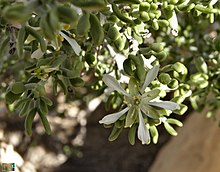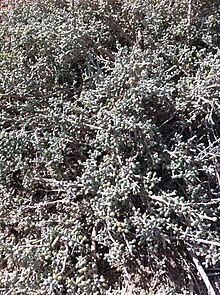Zygophyllum
| Zygophyllum | ||||||||||||
|---|---|---|---|---|---|---|---|---|---|---|---|---|

Bean-like yoke leaf ( Zygophyllum fabago ) |
||||||||||||
| Systematics | ||||||||||||
|
||||||||||||
| Scientific name | ||||||||||||
| Zygophyllum | ||||||||||||
| L. |
Zygophyllum , also called yoke leaf , is a genus of plants inthe yoke leaf family (Zygophyllaceae). The 150 or so species are widespread.
description

Appearance and leaves
Zygophyllum species often grow as more or less low, multi - stemmed semi - shrubs that reach heights of about 1 meter, often as perennial , rarely as creeping, annual herbaceous plants . Many species are xerophytic , succulent plants that are drought and salt tolerant and are thus adapted to arid climates . Sometimes the branches form a tangle, sometimes with other types of plants.
The leaves are opposite, but one of the two leaves can be reduced, giving the impression of being alternate. There may be more or less short petioles or they may be absent. The flat or stick-like, fleshy or leathery leaf blades are often two-part or, less often, one-part or rarely multi-part. The leaf sections are very different in shape and size depending on the species. The leaves fall off when conditions are too dry. Often conspicuous in this genus are the stipules , which can be membranous, herbaceous or transformed into thorns.
blossoms
The stalked flowers are single or in pairs in the leaf axils. The hermaphroditic flowers are radial symmetry , rarely four, mostly five-fold with a double flower envelope . The usually five somewhat fleshy sepals are fused at their base and membranous on the edge; they are durable or in a few species they fall off early. The rarely four, usually five free petals are often nailed, broadly obovate, elliptical, spatulate or rarely spoon-shaped. Petals are missing in a few species. The colors of the petals range from light orange to yellow or white, often with a red markings towards their base or streaked with red veins, or they are lighter on the edges. There is a ring-shaped, cup-shaped or concave, octagonal or ten-edged, fleshy disc , sometimes it is clearly three- to five-lobed or divided from the ovary chambers; the stamens sit on it. There are two circles with four or five stamens each; rarely are there only four or six stamens in total. The free, thread-like stamens are usually longer than the petals and usually have membranous, scale-shaped appendages at their base, rarely missing. The anthers are oblong-egg-shaped or rounded. Three to five carpels are fused to form an upper, three- to five- chamber ovary. Each ovary chamber contains two or more pendulous ovules . The awkward, angular style, which is shorter or longer than the fruit notes, ends in a tiny, more or less spherical to lobed stigma.
Fruits and seeds
Capsule fruits or split fruits are formed. The capsule fruits are different depending on the species; when dry, they are often furrowed or smooth ( e.g. Zygophyllum flexuosum ), three- to five-edged or winged ( e.g. Zygophyllum morgsana ). The split fruits disintegrate into two or more partial fruits. In each fruit compartment there are one, few to a few seeds. The seeds contain endosperm and a straight embryo with two elongated cotyledons ( cotyledons ).
Occurrence
The approximately 150 Zygophyllum species have a wide range from the Mediterranean to Central Asia and Africa , also in Australia , the southwestern USA and Chile . There are about 19 species in China. About 60 species occur in sub-Saharan Africa; about 47 species are native to Southern Africa : South Africa , Namibia , Botswana , Lesotho and Swaziland .
In the Capensis species occur in winter and summer rain areas. Most of the species found in the Capensis thrive in the Nama- Karoo and Succulent-Karoo biomes , both of which are arid. The Gariep region is the center of biodiversity and endemism for the South African Zygophyllum species. Most of the endemic species are found in the north-western corner of the South African province of North Cape and adjacent areas in the south-western corner of Namibia.
Zygophyllum species thrive in many of the world's deserts and semi-deserts. For example, Zygophyllum stapfii inhabits extremely dry locations in the Namib . The species thrive in a wide variety of habitats on slopes, dry rivers, on mountain ridges, at the roadside and on coarse-sand, lime-rich and salty soils .
Systematics
The genus Zygophyllum was established in 1753 by Carl von Linné in Species Plantarum , 1, pp. 385-386. The type species is Zygophyllum fabago L. The genus name Zygophyllum is derived from the Greek, from ζυγόν zygon for yoke and φυλλον phyllon for leaf and refers to the opposite leaves and leaf sections that many species have. Synonyms for Zygophyllum L. are: Halimiphyllum (Engl.) Boriss. , Miltianthus Bunge , Sarcozygium Bunge . The genus Zygophyllum belongs to the subfamily Zygophylloideae within the family of zygophyllaceae . The scope of the genus is controversial. Often the South African and Australian species are in the genus Roepera A.Juss. outsourced. However, Bellstedt et al. 2008 mark the separation of the two genera Tetraena and Roepera for premature.


There are approximately 150 Zygophyllum species (including the Tetraena and Roepera species):
- Zygophyllum aegyptium Hosny
- Zygophyllum aestuans L.
- Zygophyllum album L. f.
- Zygophyllum altaicum Stephan ex Ledeb.
- Zygophyllum amblyocarpum Baker
- Zygophyllum ammophilum F. Muell.
- Zygophyllum angustifolium H. Eichler
- Zygophyllum apiculatum F. Muell.
- Zygophyllum applanatum Van Zyl
- Zygophyllum atriplicoides fish. & CA Mey.
- Zygophyllum aurantiacum F. Muell.
- Zygophyllum aureum Dinter ex Engl.
- Zygophyllum australasicum Miq.
- Zygophyllum balchaschense Boriss.
- Zygophyllum berenicense (Muschl.) Hadidi
- Zygophyllum betpakdalense Golosk. & Semiotr.
- Zygophyllum billardierei DC.
- Zygophyllum borissovae Beier & Thulin
- Zygophyllum botulifolium Van Zyl
- Zygophyllum boulosii Hosny
- Zygophyllum brachypterum Kar. & Kir.
- Zygophyllum bucharicum B. Fedsch.
- Zygophyllum budunense Semiotr.
- Zygophyllum capense Lam.
- Zygophyllum carnosum Wall.
- Zygophyllum chrysopteron Retief
- Zygophyllum clavatum Schltr. & Diels
- Zygophyllum coccineum L.
- Zygophyllum commelini Eckl. & Zeyh.
- Zygophyllum compressum J.M.Black
- Zygophyllum confluens H. Eichler
- Zygophyllum connaroides Wight & Arn. ex here
- Zygophyllum cordatum Burm. f.
- Zygophyllum cordifolium L. f.
- Zygophyllum cornutum Coss.
- Zygophyllum crassifolium Schltr. ex Huysst.
- Zygophyllum crassissimum Ising
- Zygophyllum crenatum F. Muell.
- Zygophyllum cuspidatum Boriss.
- Zygophyllum cylindrifolium Schinz
- Zygophyllum darvasicum Boriss.
- Zygophyllum debile Cham.
- Zygophyllum decumbens Delile
- Zygophyllum desertorum Forssk.
- Zygophyllum dichotomum light. ex Cham.
- Zygophyllum divaricatum Eckl. & Zeyh.
- Zygophyllum dregeanum Sond.
- Zygophyllum dumosum Boiss.
- Zygophyllum eichleri R.M.Barker
- Zygophyllum emarginatum H. Eichler
- Zygophyllum englerianum (Popov) Popov
- Zygophyllum eremaeum Ostenf.
- Zygophyllum eurypterum Boiss. & Buhse
- Zygophyllum fabagifolium Baill.
- Zygophyllum fabagineum St.-Lag.
- Bean-like yoke leaf ( Zygophyllum fabago L. )
- Zygophyllum fabagoides Popov
- Zygophyllum fasciculatum light. ex Cham.
- Zygophyllum flavum H. Eichler ex RMBarker
- Zygophyllum flexuosum Eckl. & Zeyh.
- Zygophyllum foetidum Schrad. & JCWendl.
- Zygophyllum fontanesii Webb & Berthel.
- Zygophyllum fruticulosum DC.
- Zygophyllum fulvum L.
- Zygophyllum furcatum Van Zyl
- Zygophyllum gaetulum Emb. & Maire
- Zygophyllum garipense E. Mey .
- Zygophyllum giessii Merxm. & A. Write.
- Zygophyllum gilfillanii N.E.Br.
- Zygophyllum glaucescens F. Muell.
- Zygophyllum gobicum Maxim.
- Zygophyllum gontscharovii Boriss.
- Zygophyllum guyotii Kneuck. & Muschl.
- Zygophyllum halophilum R.M.Barker
- Zygophyllum hamiense Schweinf.
- Zygophyllum heterocladum Rech. F. & Patzak
- Zygophyllum hildebrandtii Engl.
- Zygophyllum hirticaule Van Zyl
- Zygophyllum horridum Eckl. & Zeyh.
- Zygophyllum howittii F. Muell.
- Zygophyllum humillimum Max Koch ex Tate
- Zygophyllum ifniense Caball.
- Zygophyllum iliense Popov
- Zygophyllum incanum Schinz
- Zygophyllum incrustatum E. Mey. ex Sond.
- Zygophyllum insuave Eckl. & Zeyh.
- Zygophyllum iodocarpum F. Muell.
- Zygophyllum jaxarticum Popov
- Zygophyllum kansuense Y.X.Liou
- Zygophyllum karatavicum Boriss.
- Zygophyllum karelinii fish. ex Boiss.
- Zygophyllum kegense Boriss.
- Zygophyllum kochii Tate
- Zygophyllum kopalense Boriss.
- Zygophyllum latialatum Engl.
- Zygophyllum laxum Engl. }
- Zygophyllum lehmannianum Bunge
- Zygophyllum leptopetalum E. Mey. ex Sond.
- Zygophyllum leucocladum Diels
- Zygophyllum lichtensteinianum Cham.
- Zygophyllum limosum Eckl. & Zeyh.
- Zygophyllum lobulatum (Benth.) H. Eichler
- Zygophyllum loczyi Kanitz
- Zygophyllum longicapsulare Schinz
- Zygophyllum longistipulatum Schinz
- Zygophyllum macracanthum Huysst.
- Zygophyllum macrocarpon Retief
- Zygophyllum macrophyllum Regel & Schmalh.
- Zygophyllum macropodum Boriss.
- Zygophyllum macropterum C.A.Mey.
- Zygophyllum maculatum Aiton
- Zygophyllum mandavillei Hadidi
- Zygophyllum maritimum Eckl. & Zeyh.
- Zygophyllum marliesiae R.M.Barker
- Zygophyllum marlothii Engl.
- Zygophyllum maximiliani Schltr. ex Huysst.
- Zygophyllum megacarpum Boriss.
- Zygophyllum melongena Bunge
- Zygophyllum meyeri Sond.
- Zygophyllum microcarpum Boriss.
- Zygophyllum migahidii Hadidi
- Zygophyllum migiurtinorum Chiov.
- Zygophyllum miniatum Cham.
- Zygophyllum morgsana L.
- Zygophyllum mucronatum Maxim.
- Zygophyllum neglectum Grubov
- Zygophyllum obliquum Popov
- Zygophyllum obtusum Vicary
- Zygophyllum oocarpum Loes. ex Huysst.
- Zygophyllum orbiculatum Welw. ex Oliv.
- Zygophyllum ovatum Ewart & Jean White ex Bunge
- Zygophyllum oxianum Boriss.
- Zygophyllum oxycarpum Popov
- Zygophyllum pamiricum Grubov
- Zygophyllum parvifolium G.Don
- Zygophyllum pfeilii Engl.
- Zygophyllum pinnatum Cham.
- Zygophyllum potaninii Maxim.
- Zygophyllum prismatocarpum Sond.
- Zygophyllum prismatothecum F. Muell.
- Zygophyllum procumbens Adamson
- Zygophyllum proliferum Forssk.
- Zygophyllum propinquum Decne.
- Zygophyllum prostratum Thunb.
- Zygophyllum pterocarpum Bunge
- Zygophyllum pterocaule Van Zyl
- Zygophyllum pubescens Schinz
- Zygophyllum pygmaeum Eckl. & Zeyh.
- Zygophyllum qatarense Hadidi
- Zygophyllum ramosissimum Popov
- Zygophyllum rangei Engl.
- Zygophyllum retivalve Domin
- Zygophyllum retrofractum Thunb.
- Zygophyllum rigescens E. Mey.
- Zygophyllum rigidum Schinz
- Zygophyllum robecchii Engl.
- Zygophyllum rogersii Compton
- Zygophyllum rosowii Bunge
- Zygophyllum rowelliae R.M.Barker
- Zygophyllum schaeferi Engl.
- Zygophyllum schreiberianum Merxm. & Giess
- Zygophyllum semiteres Eckl. & Zeyh.
- Zygophyllum sessilifolium L.
- Zygophyllum sieversianum Stephan ex Ledeb.
- Zygophyllum simile H. Eichler
- Zygophyllum simplex L.
- Zygophyllum sinkiangense Y.X. Liou
- Zygophyllum smithii Hadidi
- Zygophyllum somalense Hadidi
- Zygophyllum sonderi H. Eichler
- Zygophyllum spatulatum D.Don
- Zygophyllum sphaerocarpum Schltr. ex Huysst.
- Zygophyllum spinosum L.
- Zygophyllum stapfii Schinz
- Zygophyllum stellulatum C.Sm.
- Zygophyllum stenopterum Schrenk
- Zygophyllum subtrijugum C.A.Mey.
- Zygophyllum succulentum Salisb.
- Zygophyllum suffruticosum Schinz
- Zygophyllum sulcatum Huysst.
- Zygophyllum taldykurganicum Boriss.
- Zygophyllum tenue R.Glover
- Zygophyllum teretifolium Schltr.
- Zygophyllum terminale Turcz.
- Zygophyllum tesquorum J.M.Black
- Zygophyllum tetrapterum H.Eichler ex RMBarker
- Zygophyllum thunbergianum Eckl. & Zeyh.
- Zygophyllum trialatum fish. ex Boiss.
- Zygophyllum typicum (Popov) C. Rule
- Zygophyllum uitenhagense Sond.
- Zygophyllum waterlotii Maire
- Zygophyllum webbianum Coss.
- Zygophyllum xanthoxylon (Bunge) Maxim.
- Zygophyllum zanthoxylum Engl. Ex Dippel
- Zygophyllum zonuzensis Sabeti
swell
- Karl Pollmann: Dissertation: Isolation and structural analysis of bioactive natural substances from Egyptian plants of the genus Zygophyllum . Bayreuth 1998.
- Yingxin Liu & Lihua Zhou: Zygophyllaceae : Zygophyllum , pp. 45-46 - Online , In: Wu Zheng-yi, Peter H. Raven, Deyuan Hong (eds.): Flora of China , Volume 11: Oxalidaceae through Aceraceae , Missouri Botanical Garden Press and Science Press, Beijing and St. Louis 2008, ISBN 978-1-930723-73-3 . (Section description)
- Abdul Ghafoor: Zygophyllaceae : Zygophyllum in the Flora of Pakistan , Volume 76. (Section Description)
- Elizabeth Retief: Zygophyllum L. , 2009 at plantzafrica.com from SANBI = South African National Biodiversity Institute . (Section Description and Distribution)
- H. Eichler: Entry in New South Wales Flora Online .
- Björn-Axel Beier, Mark W. Chase & Mats Thulin: Phylogenetic relationships and taxonomy of subfamily Zygophylloideae (Zygophyllaceae) based on molecular and morphological data , In: Plant Systematics and Evolution , Volume 240, 2003, pp. 11-39. doi : 10.1007 / s00606-003-0007-0
- DU Bellstedt, L. van Zyl, EM Marais, Benny Bytebier, CA de Villiers, AM Makwarela & LL Dreyer: Phylogenetic relationships, character evolution and biogeography of southern African members of Zygophyllum (Zygophyllaceae) based on three plastid regions , In: Molecular Phylogenetics and Evolution , Volume 47, Issue 3, 2008, pp. 932-949.
Individual evidence
- ↑ a b c d e f g h i j k Abdul Ghafoor: Zygophyllaceae : Zygophyllum in the Flora of Pakistan , Volume 76.
- ↑ a b c d e f g Elizabeth Retief: Zygophyllum L. , 2009 at plantzafrica.com from SANBI = South African National Biodiversity Institute .
- ↑ a b c d e f g h Yingxin Liu & Lihua Zhou: Zygophyllaceae : Zygophyllum , pp. 45-46 - Online , In: Wu Zheng-yi, Peter H. Raven, Deyuan Hong (eds.): Flora of China , Volume 11: Oxalidaceae through Aceraceae , Missouri Botanical Garden Press and Science Press, Beijing and St. Louis 2008, ISBN 978-1-930723-73-3 .
- ↑ a b c d e H. Eichler: Entry in New South Wales Flora Online .
- ↑ First publication scanned at biodiversitylibrary.org .
- ^ Zygophyllum at Tropicos.org. Missouri Botanical Garden, St. Louis
- ↑ Zygophyllum in the Germplasm Resources Information Network (GRIN), USDA , ARS , National Genetic Resources Program. National Germplasm Resources Laboratory, Beltsville, Maryland.




